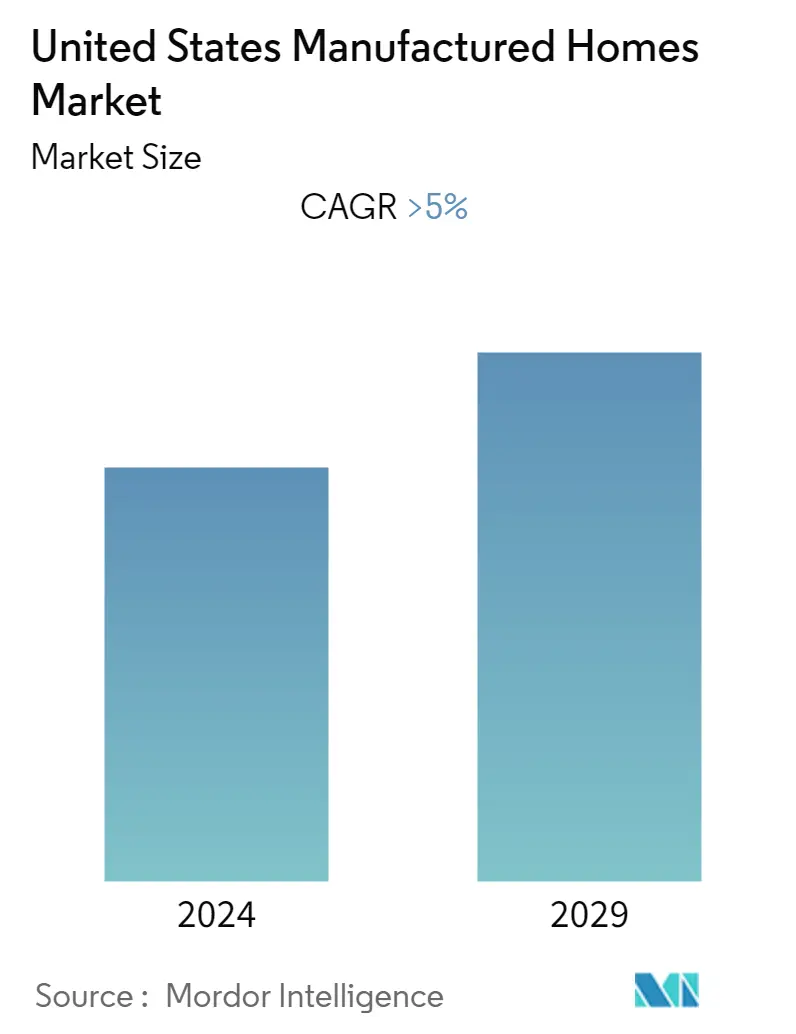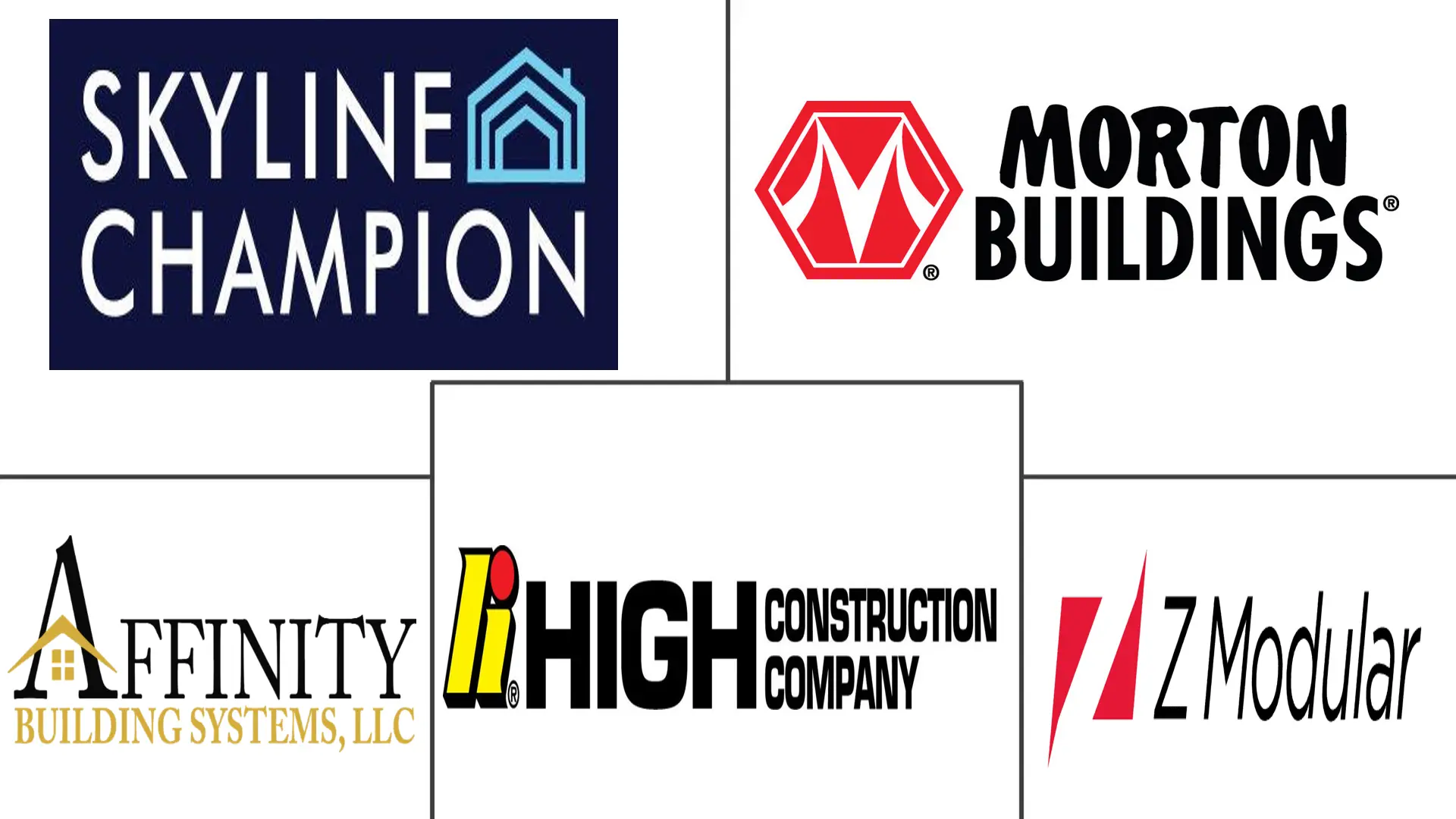Market Size of United States Manufactured Homes Industry

| Study Period | 2020 - 2029 |
| Base Year For Estimation | 2023 |
| Forecast Data Period | 2024 - 2029 |
| Historical Data Period | 2020 - 2022 |
| CAGR | 5.00 % |
| Market Concentration | Low |
Major Players
*Disclaimer: Major Players sorted in no particular order |
US Manufactured Homes Market Analysis
The United States manufacturing housing market is expected to grow at a CAGR of more than 5% during the forecast period. The need for high-quality, reasonably priced homes has never been higher. Modern prefabricated homes are up to 50% less expensive per square foot than traditional site-built homes while yet providing exceptional quality and performance. Even in the face of a disparity in housing affordability that is always expanding, these savings enable more and more Americans to purchase their own house.
- The factory-building process's effectiveness makes prefabricated houses so reasonably priced. Manufactured homes are made nearly entirely off-site in a factory using standard building components.
- The controlled construction environment and assembly line processes eliminate many of the issues that arise during conventional home construction, such as weather, theft, vandalism, damage to building materials and supplies, and inexperienced workers. Compared to the system of outsourced labor used by the site-built house construction industry, factory workers are educated and controlled more successfully and efficiently.
- Similar to other assembly line processes, prefabricated houses profit from economies of scale brought about by buying huge numbers of components, goods, and appliances. When purchasing a manufactured home, the customer benefits directly from the manufacturer's ability to negotiate significant discounts on various building materials.
US Manufactured Homes Industry Segmentation
The report provides a thorough background analysis of the US manufactured home market, including an evaluation of the economy and the contribution of various economic sectors, a market overview, market size estimates for important market segments, emerging market segment trends, market dynamics, geographical trends, and the COVID-19 impact. The report provides a thorough background analysis of the US manufactured home market, including an evaluation of the economy and the contribution of various economic sectors, a market overview, market size estimates for important market segments, emerging market segment trends, market dynamics, geographical trends, and the COVID-19 impact.
The United States Manufactured Homes Market is segmented By Type (Single Family and Multi-Family). The report offers size and forecasts for the United States Manufactured Homes Market in value (USD billion) for all the above segments.
| By Type | |
| Single Family | |
| Multi Family |
United States Manufactured Homes Market Size Summary
The United States manufactured homes market is poised for significant growth, driven by the increasing demand for affordable and high-quality housing solutions. Prefabricated homes, which are constructed off-site in a controlled factory environment, offer a cost-effective alternative to traditional site-built homes. This method of construction mitigates common issues such as weather-related delays, theft, and material damage, while also benefiting from economies of scale in purchasing building materials. As a result, manufactured homes are typically less expensive per square foot, making them an attractive option for many American households facing rising housing costs. The market is characterized by a diverse range of players, from international corporations to local businesses, all contributing to the sector's dynamic landscape.
The affordability crisis in the U.S. housing market has intensified, prompting a shift towards manufactured homes as a viable solution for lower and moderate-income families. Despite the overall increase in housing prices, manufactured homes remain a more economical choice, with their average sale price rising in line with broader real estate trends. The popularity of these homes varies regionally, with southern states like Texas, Florida, and North Carolina leading in their adoption. The market is further bolstered by strategic acquisitions and expansions by key players such as Skyline Champion Corporation and Champion Home Builders, which enhance their manufacturing capabilities and retail presence. This growth trajectory underscores the evolving role of manufactured homes in addressing the nation's housing affordability challenges.
United States Manufactured Homes Market Size - Table of Contents
-
1. MARKET INSIGHTS
-
1.1 Current Market Scenario
-
1.2 Supply Chain / Value Chain Analysis
-
1.3 Technological Innovations in the Manufactured Homes Market
-
1.4 Government Regulations and Initiatives in the Industry
-
1.5 Insights into Manufactured House Costs
-
1.6 Impact of COVID-19 on the Market
-
-
2. MARKET SEGMENTATION
-
2.1 By Type
-
2.1.1 Single Family
-
2.1.2 Multi Family
-
-
United States Manufactured Homes Market Size FAQs
What is the current United States Manufactured Homes Market size?
The United States Manufactured Homes Market is projected to register a CAGR of greater than 5% during the forecast period (2024-2029)
Who are the key players in United States Manufactured Homes Market?
Skyline Champion Corporation, Morton Buildings, Inc., The High Construction Company, Z Modular and Affinity Building Systems are the major companies operating in the United States Manufactured Homes Market.

